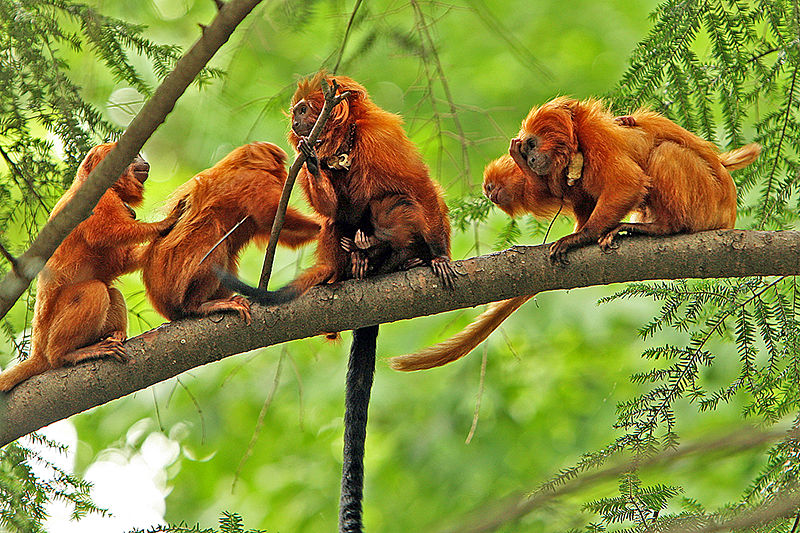A Primates Eyes
Interview with
Dr Andrew Smith works with Tamarin monkeys in South America and the endangered Buton macaque with Operation Wallacea in Indonesia.
Chris - Tell us about this work on how monkeys use colour, and why this is relevant to us.
Andrew - Certainly, I've been researching on primate colour vision. It's an interesting topic because primates unlike the majority of animals have got three cone colour vision, which means they can see the same range of colours, more or less, as we can. Non-primate mammals such as dogs and cats see the world in a reduced set of colours, and we weren't entirely sure why this was the case.
Chris - People often say that dogs see the world in black and white, but that's not true. A dog sees the world in colour, but probably akin to how a colour blind human would see.
Andrew - Exactly, if you imagine a dulux colour chart, it's just a reduced set of those colours, not being able to distinguish certain combinations of those, rather than simply seeing the world in black and white or 'an other colour' and white.
Chris - So how was it first discovered that monkeys and other primates did have this ability, it wasn't just us?
Andrew - What they were doing was looking at colour vision capabilities by giving them more or less the same tests that they were giving humans; basically asking them to discriminate between different coloured shapes. If they could tell the difference between the colours then obviously they can tell that those are separate and distinct colours.
Chris - So it's set up so that there's no way they could do that by having two colour- they had to have three colour vision to do that.
Andrew - Yes.
Chris - So what's your view on the reason why they have got that ability?
Andrew - I think the main reason is probably due to foraging ability, so being able to detect fruit against a background of leaves. Leaves are invariably green, but many fruits when they're ripe - which is when plants want animals to eat them and also when they will contain the most amounts of sugars and nutrients, are often orange, yellow or reddish. The ability to distinguish ripe fruits from a background of leaves, which obviously if you are human and colour blind its likely that you have distinct problems telling the difference between red and green, if you cant do this it will be difficult for you to pick out red fruits against a green background. Evolving good three cone or trichromatic colour vision is going to enable primates to choose the ripe fruits against a green background of leaves.
Chris - Is that what we have to thank for the fact that we have such good colour vision?
Andrew - We think so. That's probably the leading theory although there are alternatives that maybe it has evolved to enable you to pick out very young leaves. Young leaves are much more nutritious, they've got less noxious secondary compounds in them than old leaves. For folivorous, leaf eating, monkeys such as howler monkeys or gorillas, and maybe our human ancestors, the ability to pick out the newest, youngest, tenderest leaves may have been a selective advantage for the evolution of three cone colour vision.
Chris - We're not herbivorous, we're omnivorous so we eat some meat but you would have thought that other animals, that actually spend their entire life eating leaves, are dependant on eating plants all the time just to survive. It would be even more important to them, wouldn't it? So why don't cows and sheep and goats have that ability?
Andrew - It's possible that cows and sheep simply haven't had the chance mutation to develop three cone colour vision, and also, being much larger animals they have to graze and consume much larger quantities. Also it really depends on the type of leaf you're talking about. The leaves in terms of primate colour vision are from tropical forests where predation pressure on the leaves is quite high, and interestingly they do flush through a kind of pinkish-red when they're new leaves. However in grasses, the new leaves are basically the same as, or very similar to the adult leaves.
Chris - Is it just fruit that they use this enhanced colour appreciation for or could there be other spin-offs?
Andrew - There could be other spin-offs; it may help to detect predators. If you think about the coats of many cats in rainforests, such as ocelots, margays, jaguars, or indeed leopards, the yellowish hues in their coats may be more easily distinguished if you've got good three cone colour vision.
Kat - Another thing that's important as well as being able to spot predators is to actually find somewhere safe top sleep when you're trying to avoid predators. How do monkeys cope with that when they're living in the wild?
Andrew - It certainly seems for the small monkeys, the tamarins from the Amazon that I've been looking at that, predation is probably one of the most important aspects of their ecology. What they do is try to find the most secure sites, usually high up in trees, often hidden by dense tangles of vegetation and lianas. Also the monkeys really use the sites very infrequently; they change their sleeping site almost every night. The longest I've ever known them to sleep in the same site for is three consecutive nights. This is probably to stop any predators in the area building up a search image and maybe smelling a distinct monkey scent from a particular tree that they've been sleeping in a lot. By changing their sleeping sites very frequently they're hoping to avoid predators.
- Previous Meerkats - Happy Families?
- Next Enceladus' Old Faithful










Comments
Add a comment